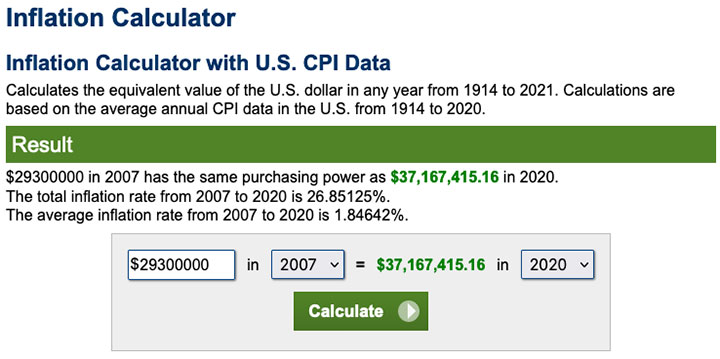The reasons for government growth — here in Pagosa Springs, or anywhere — are complicated, and they are not always related to population growth. But when I did a bit of analysis on the Archuleta County budget, I was actually surprised at what I found.
From a certain perspective, the growth of Archuleta County government spending appears quite reasonable. If you don’t include the amount of new debt.
We noted, in Part One, the annual population growth predicted by water engineer Steve Harris — “5 to 7 percent” — back in 2007 when he wrote a report explaining the overwhelming need for a new 35,000 acre-foot reservoir in the Dry Gulch Valley, just northeast of downtown Pagosa Springs.
With the benefit of hindsight, we note that our actual population growth, since 2007, has averaged less than one percent per year.
Mr. Harris also predicted that by 2020, Pagosa Area Water and Sanitation (PAWSD) would be seeing an annual water demand of 6,246 acre-feet.
The actual demand, last year, was closer to 2,200 acre-feet, and that included the raw water used by the Pagosa Springs Golf Course, and 500 acre feet lost to leaking pipes. Actual PAWSD sales of treated water, in 2020, were closer to 1,250 acre-feet.
2007 is an interesting year to choose, of course, when considering the growth of Archuleta County and its governments. Although many of us in Pagosa probably didn’t notice it, the local construction industry was already slowing down in 2007, following 15 years of rather furious development activity.
By 2008, the entire U.S. was aware that the housing bubble was suddenly deflating. By 2009, the nation was in an obvious financial mess… and Archuleta County was actually losing population.
How did the population growth patterns affect local government growth… between, say, 2007 and 2020? As noted in Part One, the population of Archuleta County in 2007 was about 12,432. The U.S. Census pegged the 2020 population at 13,359…a total increase of about 7% over 13 years.
We can start with the Archuleta County budget, as an example.
The total expenditures for the County government in 2007, amounted to $27.4 million. If the County had grown its spending at a rate commensurate with population growth over the next 13 years (7%), the County budget in 2020 would have been about $29.3 million. But we need to allow for inflation, as well, and we can do that using an online inflation calculator:

So… accounting for population growth and inflation, a 2007 budget of $27.4 million could be expected to grow to about $37.2 million by 2020.
How did we do… considering that the County hasn’t made any significant additions to its menu of services since 2007?
The County spent about $37.5 million in 2020. Pretty much right on the button… except, perhaps, for the fact that a relatively larger portion of the 2020 budget was directed to law enforcement and dispatch services.
When the Archuleta Board of County Commissioners adopted their annual budget for 2007, the total allocated for Sheriff’s Office operations — including detention, patrol, investigations, dispatch, administration, animal control, etc — totaled about $3.3 million. If the Sheriff’s Office budget had increased at the same rate as the Archuleta County population — 7% — the budget for 2020 would have been about $3.5 million. After accounting for inflation (as we ought to do) the Sheriff’s 2020 budget would have been about $4.4 million.
Glancing quickly at historical budgets, it would appear that 2020 expenditures by the Sheriff’s Office were: $4.1 million. Less than we might expect. But there were a couple of mitigating situations. In 2007, the Sheriff’s Office was running its own County Detention Center. The jail was abandoned in 2015, and a new jail was planned, and finally occupied in November 2020. For most of 2020, Archuleta County inmates were housed at the La Plata County jail, at a much lower cost than operating an Archuleta County detention center.
Also, the Sheriff’s budget in 2007 had included “Dispatch”, budgeted at $409,000. In the 2020 budget, “Combined Dispatch” had been moved to its own department, with its own budget totaling about $1.2 million. If we add that to the Sheriff’s Office total, we get $5.3 million.
That suggests relative growth of the Sheriff’s Office budget, between 2007 and 2020, of about 27%… not 7%. The growth of the Dispatch budget, by itself, was about 230%, even after accounting for inflation. As far as I can tell, no other County department has seen such significant growth.

Department operations are just part of the story, however. Archuleta County also saw changes in its debt burden between 2007 and 2020.
In 2007, Archuleta County had debt obligations of $2.1 million for County Airport improvements, and $1.5 million for equipment purchases, for a total debt burden of about $3.6 million. All of those debts would be paid off by 2014, according to the published County budget.
By the end of 2020, the Board of County Commissioners had managed to establish debt obligations totaling $25.6 million, with most of the debt requiring annual payments through 2044. In addition, the County 2020 budget showed the BOCC spending down its fund reserves — its savings accounts — by $7.7 million.
If we include the new debt obligations and the use of reserves slowly accrued over the past decade, the $37.5 million actually spent in 2020 is only part of the picture.
But that’s American-style finances for you. We’re taught to make maximum use of debt, and to spend down our savings whenever the opportunity arises. In exchange for this lavish spending during the past three or four years, we’ve been blessed with — for instance — an (oversized?) County jail that will apparently cost us close to $2.8 million per year, in debt payments and operational costs.
Just a little less than the budget for the entire Sheriff’s Office in 2007.
Remarkably, the COVID pandemic has resulted in record-setting tax collections for Archuleta County, and also for the Town of Pagosa Springs. So, maybe we don’t have to worry about things like long-term debt, and spending down reserves?
Tomorrow we’ll take a look at the Town’s budget growth over the past 13 years, and see how our municipality has been using its citizens’ tax contributions.

